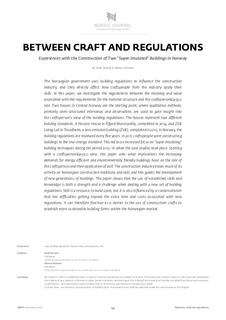| dc.contributor.author | Woods, Ruth | |
| dc.contributor.author | Korsnes, Marius | |
| dc.date.accessioned | 2018-04-10T13:16:24Z | |
| dc.date.available | 2018-04-10T13:16:24Z | |
| dc.date.created | 2018-01-08T12:47:05Z | |
| dc.date.issued | 2017 | |
| dc.identifier.citation | Nordic Journal of Science and Technology Studies. 2017, 5 (2), 59-70. | nb_NO |
| dc.identifier.issn | 1894-4647 | |
| dc.identifier.uri | http://hdl.handle.net/11250/2493480 | |
| dc.description.abstract | Building regulations set standards that aim to reduce energy use and CO2 emissions, and thereby to support the development of a more sustainable building stock. The Norwegian government uses building regulations to influence the construction industry, and they directly affect how craftspeople from the industry apply their skills. Regulations are converging with understandings about sustainability, energy use, building materials, and comfort requirements that are circulating in society. In this paper, we investigate the negotiations between the meaning and value associated with the requirements for the material structure and the craftsperson’s role. Two houses in Central Norway are the starting point, where qualitative methods, primarily semi-structured interviews and observation, are used to gain insight into the craftsperson’s view of the Norwegian building regulations. The two houses represent two different building standards. A Passive House in Åfjord Municipality, completed in 2014, and ZEB Living Lab in Trondheim, a zero emission building (ZEB), completed in 2015. In Norway, the building regulations are reviewed every five years. In 2011, craftspeople were constructing buildings to the low-energy standard. This led to an increased focus on “super insulating” building techniques during period 2013-16 when the case studies took place. Starting with a craftsperson’s (in this case most often a carpenter’s) view of current and future building standards, this paper asks what implications the increasing demands for energy efficient and environmentally friendly buildings have on the role of the craftsperson and their application of skill. The paper shows that the construction industry bases much of its activity on Norwegian construction traditions and skill; and that this guides the development of new generations of buildings. The use of established skills and knowledge is both a strength and a challenge when dealing with a new set of building regulations. Skill is a resource to build upon, but it is also influenced by a conservativism that has difficulties getting beyond the extra time and costs associated with new regulations. It can therefore function as a barrier to the use of construction crafts to establish more sustainable building forms within the Norwegian market. | nb_NO |
| dc.language.iso | eng | nb_NO |
| dc.publisher | NTNU Norwegian University of Science and Technology | nb_NO |
| dc.rights | Navngivelse-DelPåSammeVilkår 4.0 Internasjonal | * |
| dc.rights.uri | http://creativecommons.org/licenses/by-sa/4.0/deed.no | * |
| dc.title | Between craft and regulations: experiences with the construction of two “super insulated” buildings in Norway | nb_NO |
| dc.type | Journal article | nb_NO |
| dc.type | Peer reviewed | nb_NO |
| dc.description.version | publishedVersion | nb_NO |
| dc.source.pagenumber | 59-70 | nb_NO |
| dc.source.volume | 5 | nb_NO |
| dc.source.journal | Nordic Journal of Science and Technology Studies | nb_NO |
| dc.source.issue | 2 | nb_NO |
| dc.identifier.doi | http://dx.doi.org/10.5324/njsts.v5i2.2322 | |
| dc.identifier.cristin | 1537651 | |
| dc.description.localcode | This work is licensed under a Creative Commons Attribution-ShareAlike 4.0 International License. | nb_NO |
| cristin.unitcode | 194,62,40,0 | |
| cristin.unitname | Institutt for tverrfaglige kulturstudier | |
| cristin.ispublished | true | |
| cristin.fulltext | original | |
| cristin.qualitycode | 1 | |

